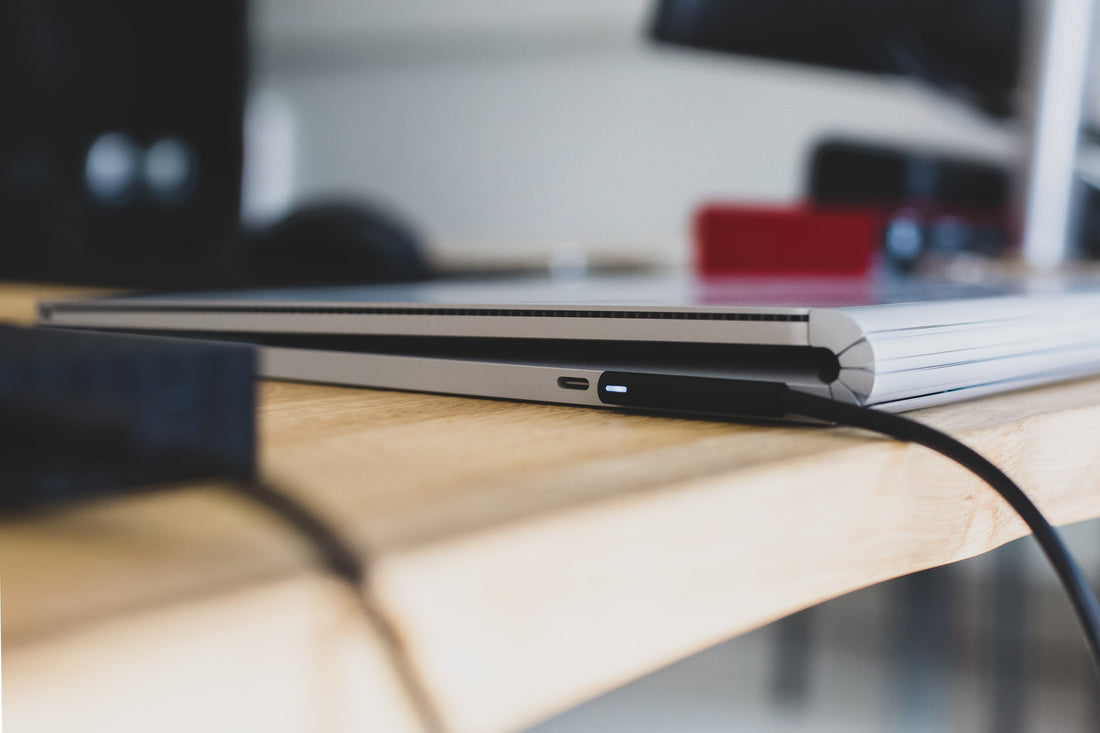As frustrating as it can be, having your laptop plugged in but not charging is a common issue. This often leaves users puzzled, questioning the health and functionality of their device.
In this article, we’ll guide you through initial checks and basic troubleshooting steps to identify and resolve this problem. Whether it’s a faulty power adapter, a broken laptop charger, or an issue with your laptop’s charging port, understanding how to diagnose and fix charging issues is crucial for any laptop user.
Initial Checks and Basic Troubleshooting
When faced with a laptop that’s plugged in but not charging, start with some basic troubleshooting:
- Check Power Outlet and Connections: Ensure the power cord is firmly connected to both the laptop’s power connector and the wall outlet. Test the outlet with another device to confirm it’s working.
- Inspect the Power Cord and Adapter: Look for any signs of damage on the power cable and the power adapter. Fraying, bends, or burns can indicate a problem. Try using a different power cord or adapter, if available, to see if the issue persists.
- Battery Inspection: If your laptop has a removable battery, take it out and inspect it for any signs of damage or bulging. Reinsert it ensuring a secure connection.
- Power Button Reset: With the power cord disconnected and the battery out (if removable), hold down the power button for about 15 seconds to reset the internal power supply.
- Check the Laptop’s Charging Port: Look for any debris or damage in the laptop’s charging port which might prevent a proper connection.
These initial steps can often resolve simple issues related to power supply and connection. If your laptop still isn’t charging, further investigation into battery health, software settings, or potential hardware problems may be necessary.
Battery Health and Maintenance
Maintaining your laptop’s battery health is a crucial aspect of ensuring consistent performance and longevity. To determine the current health of your laptop battery, you can access the system settings or use a dedicated utility. These tools provide valuable information on battery capacity and wear level, helping you gauge its overall condition.
For optimal battery maintenance, it’s important to consider a few best practices. Firstly, try to avoid exposing your laptop to extreme temperatures, as they can significantly accelerate battery wear. Additionally, it’s not advisable to leave laptop batteries fully discharged or fully charged for extended periods, as this can also impact their lifespan. Periodically calibrating the battery, which involves fully discharging and then recharging it, can help maintain its accuracy and efficiency. By following these guidelines, you can help ensure your laptop battery remains healthy and functional for as long as possible.
Software and Driver Considerations
When troubleshooting a laptop that’s plugged in but not charging, it’s essential to consider software and driver factors:
- Updating Battery Drivers: Outdated or corrupt battery drivers can cause charging issues. To update them, open the ‘Device Manager’ in Windows 10, find the battery drivers, right-click, and select ‘Update driver.’ Alternatively, you can visit the laptop manufacturer’s website for the latest drivers.
- Checking Power Management Settings: Incorrect settings in the power management can impede charging. Access the ‘Power Options’ in the control panel, and ensure the settings align with your typical usage and charging patterns.
Dealing with Hardware Issues
If the charging issue persists after software checks, it might be a hardware-related problem:
- Physical Damage Inspection: Carefully inspect your laptop for any signs of physical damage, particularly around the charging port and the area where the battery is housed. Damage here can often lead to charging problems.
- Professional Repair Consideration: If you suspect hardware faults, such as a malfunctioning charging port or internal damage, it’s advisable to seek professional repair services. Attempting DIY repairs on complex hardware issues can lead to further damage if not done correctly.
Advanced Troubleshooting Techniques
For more complex charging issues, advanced troubleshooting may be necessary:
- BIOS Update and Reset: Sometimes, updating the BIOS (Basic Input/Output System) can resolve charging issues, especially if they’re related to system management. Check the manufacturer’s website for updates. Additionally, resetting the BIOS to default settings can sometimes clear errors that affect charging.
- Testing with a Different Charger or Battery: If possible, try using a different charger or battery that’s compatible with your laptop. This can help you determine if the problem lies with the charger, the battery, or the laptop itself.
These advanced steps should be approached with caution and are often best suited for users with a bit of technical know-how or under the guidance of a professional.
When to Replace the Battery or Charger
Identifying when to replace your laptop’s battery or charger is crucial:
- Battery Replacement Indicators: If your laptop’s battery health is significantly degraded, or if it fails to hold a charge even after troubleshooting, it might be time for a replacement.
- Choosing a Replacement Charger: Similarly, if a different charger works with your laptop, your original charger may need replacing. Always opt for a charger from the manufacturer or a trusted third-party provider to ensure compatibility and safety.
Replacing a failing battery or charger is often a straightforward solution to charging issues and can extend the lifespan of your laptop.
Prevention and Best Practices
To prevent future charging issues:
- Regularly check and maintain your laptop’s battery and charger to identify potential problems early.
- Follow best practices for charging, such as not overcharging the battery and avoiding extreme temperatures.
- Handle charging cables and connectors gently to prevent physical damage.
Conclusion
A laptop that’s plugged in but not charging can be addressed through a series of systematic troubleshooting steps. From checking basic connections and battery health to considering software updates and professional repairs, these methods cover a wide range of potential solutions.Remember, regular maintenance and mindful usage are key to preventing similar issues in the future. For those seeking reliable laptops and insightful tips on computer maintenance, Vaio is your go-to source for quality devices and valuable information.

